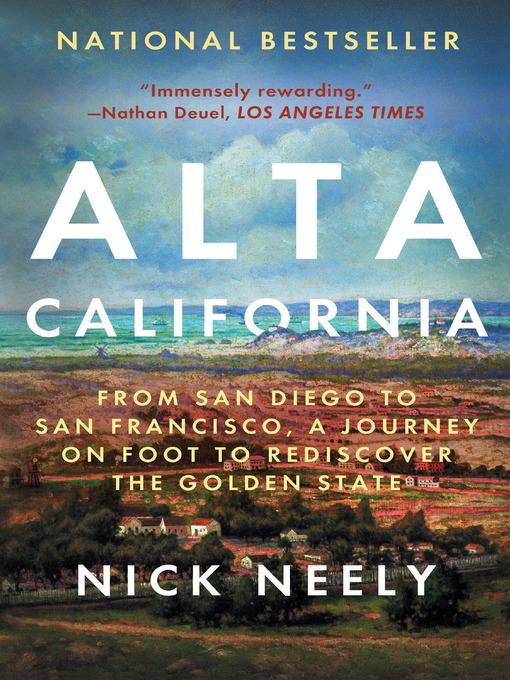
Alta California
From San Diego to San Francisco, A Journey on Foot to Rediscover the Golden State
کتاب های مرتبط
- اطلاعات
- نقد و بررسی
- دیدگاه کاربران
نقد و بررسی

September 6, 2019
To create this book, Neely (Coast Range) spent 12 weeks on a journey to retrace the first overland Spanish expedition through California. In 1789, Gaspar de Portol� led a group of Spaniards up the California coast on what has been called "The Sacred Expedition." The trek spanned from San Diego to the San Francisco Bay and would come to be a part of the famous El Camino Real, which linked the 21 Spanish missions. This was an important part of California's history and, to Neely's knowledge, no one had hiked the Portol� route before. A California native, the author had considered hiking the Pacific Crest Trail but felt it had "become something of a highway." Interested in learning more of the history of his childhood state, he embarks on an adventure using guidebooks and journals from the Portol� time period, detailing his nights in a two-pound solo tent in stretches that were both urban and remote. VERDICT Neely's account is a solid mix of adventure story and history lesson. Recommended for anyone interested in California history.--Gary Medina, El Camino Coll., Torrance, CA
Copyright 2019 Library Journal, LLC Used with permission.

September 15, 2019
A chronicle of the author's 12-week, 650-mile journey, on foot, from San Diego to San Francisco, tracing a Spanish expedition of 64 men and 50 mules led by Capt. Gaspar de Portol� from July 14 to Nov. 6, 1769. As journalist and essayist Neely (Coast Range: A Collection From the Pacific Edge, 2016) writes, the party was tasked with mapping Monterey Bay, which Spain saw as a strategic outpost, and determining sites for future Catholic missions to convert some 300,000 natives and help the nation hold coveted territory. Several members of Portol�'s expedition kept journals to which the author refers frequently as he compares his own journey with that of his predecessors. Neely's task has no international consequences: He just wanted to get acquainted with the land, and he shares his experiences in meticulous, sometimes overwhelming detail. Throughout the narrative, the author offers precise and often lyrical descriptions of landscapes and vistas, sky and sea, flora and fauna. He recounts his conversations, the food he ate, fences and No Trespassing warnings that impeded him, menacing traffic, signs of urban blight (graffiti, dumpsters, dumped trash), and surprising insect life: a tarantula as big as his palm, for example, with bristles "tinged with red, especially on its bulbous abdomen." He was also bitten, between his toes, by big ants as he nestled in his sleeping bag. Along the way, Neely inevitably encountered tourist sites. At Mission San Juan Capistrano, for example, he notes the "commercialization and fetishization of California's missions, trafficking in mystique and fantasy." He visited the La Brea Tar Pits Museum, where he engaged with an interactive display inviting him to "Discover what it's like to be trapped in tar." He also saw evidence of opulent wealth at the Getty Museum, which conveys "a sepulchral feel, as if Getty's bones were hidden behind some unidentified stone block," and the grand 165-room Hearst Castle, which overlooks "the gilded, retina-burning Pacific." A sprawling record of a unique adventure.
COPYRIGHT(2019) Kirkus Reviews, ALL RIGHTS RESERVED.

October 15, 2019
In 1769, a group of 64 men traveled from San Diego to San Francisco in the first overland Spanish expedition through the state of California. About two and a half centuries later, Neely set out on the 650-mile journey to follow in their footsteps. With the help of the meticulous document kept by the expedition's diarist, a Franciscan friar, Neely observes the many changes the intervening years have left on the California landscape. Where once there were forests and native villages, now there are highways and the sprawl of suburbia. But he still finds wildness among the outcroppings of modern life, from ants and coyotes to the call of a mountain lion a mere 20 feet away. As he travels north, Neely delves into the legacy left behind by the original expedition. This split view of two Californias not only delivers a detailed retracing of the 1769 expedition, but it also examines the massive changes that the state and its people have undergone in 250 years.(Reprinted with permission of Booklist, copyright 2019, American Library Association.)

August 12, 2019
In this detailed travel memoir, environmental writer Neely (Coast Range) relates his 650-mile walk in the footsteps of an 18th-century Spanish exploration along the coast of California. In 1769, the Portola expedition went overland from what became the towns of San Diego to San Francisco, setting the stage for the settlements, forts, and Catholic missions that would become California. Neely relies heavily on expedition journals along his walk, especially one by a friar named Juan Crespi, and reimagines the near untouched splendor of the West Coast. Even walking through subdivisions and cities and along highways, he finds poetic images in the most unlikely places (“The holy red palms of an In-N-Out cup. A water bottle of sunflower seed husks like a ravaged birdfeeder from someone’s lips”) and encounters many of those who rely on the land—surfers, farm laborers, winemakers. Along the way, he explores the roots of such famous Californians as José Francisco Ortega (founder of the Ortega chili company), writer John Steinbeck, civil engineer William Mulholland, and John Paul Getty. Neely ends in the Bay Area under a redwood tree where the Portola expedition camped, with the hope that the tree “might live another thousand years.” Neely’s naturalist, erudite work will appeal to readers of Thoreau’s Walden and Edward Abbey's Desert Solitaire. (Nov.)Correction: An earlier version of this review misspelled Edward Abbey's last name.

























دیدگاه کاربران